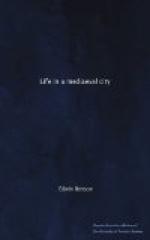Parish Churches, which were the centres of the religious life of the laity, were everywhere. In the fifteenth century there were forty-five churches and ten chapels, so that there was always a place in church for every citizen.
A church was always in use. Besides the regular public services which took place frequently during the day, and the special services for festivals, there were services in chantries. Both the high altar in the chancel and altars in other parts of a church were used. Several altars were necessary because the number of masses, for the celebration of which money was liberally bequeathed, was very large. The parish church was used for other than purely religious purposes. It was the central meeting-place of the parish, and might be described as the seat of parochial government. Meetings were held in the Nave. Parts of the church were used as schools. The parish church was also the depot for the equipment of those members who became soldiers. Moreover, fire-buckets (generally of leather) were often kept in the church, since, being of stone, it was perhaps the safest building in the parish. There were also long poles with hooks at the end used to pull thatch away from burning houses.
Most, if not all, of these churches were fine specimens of the architecture of the Middle Ages, the so-called Gothic architecture, which is characterised by pointed arches, ribbed vaulting, and the constant use of the buttress. These churches were, in contrast to the present condition of most of those that remain, complete with chancel, nave and aisles, towers or spires, bells, stained-glass windows, and furniture, many of them being particularly rich in one or more of these features. The painted windows[9] are especially interesting, for they show the standard of this branch of fifteenth-century art and are valuable historical documents. The rich, mellow tones of colour should be noted, also the incidental pictures of mediaeval dress and furniture. It is interesting to compare the fifteenth-century work with that done, for instance, by the William Morris firm to the designs of Burne-Jones (1833-1898), at a time when the revived art, with other forms of decoration, was enjoying a period of great success. In the fifteenth century the church was flourishing materially, at least, and money and gifts were freely given.
The offices and services in churches were recited and sung. Organs were used, but were not very large and were capable of being carried about: although working on similar principles to the modern organ they lacked its size, power, and varied capacity. At the Minster there were several organs, for instance “the great organs,” “the organs in the Choir,” “the organs at the Altar B.V.M.”




